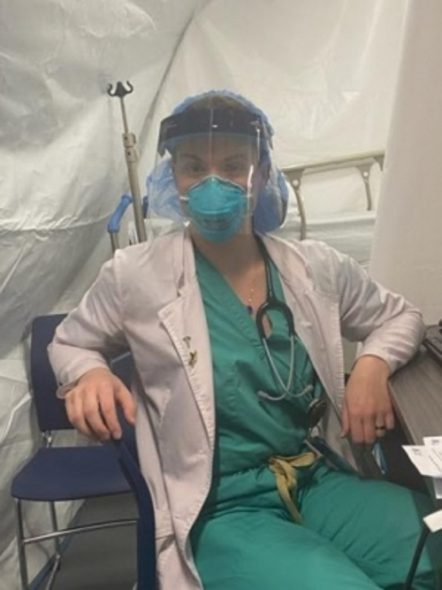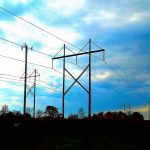Wisconsin Nurse Practitioner Joined COVID-19 Fight in NYC
Jackie Christianson volunteered to work in an emergency department at the epicenter of the disease in the US.

Wisconsin nurse practitioner Jackie Christianson takes a break in the COVID-19 tent hospital to document on her patients in New York City. Photo from Jackie Christianson.
New York City is the country’s largest hot spot for COVID-19 cases.
According to data from the New York City Health Department, as of April 8, there were over 80,000 confirmed cases, more than 20,000 people hospitalized and 4,260 deaths linked to the coronavirus outbreak that is sweeping across the country and the world.
The numbers continue to grow, dangerously stressing the health care system in New York City. As a result, both supplies and staff have come from across the country to help.
Jackie Christianson is a nurse practitioner who traveled from Wisconsin to New York City to work in an emergency department during the COVID-19 pandemic. She had originally planned to take vacation time in April, but said she changed her mind as she saw what was going on.
“It seems silly for me to sit on the sidelines when there’s a crisis going on,” she said.
As a nurse practitioner, Christianson performs much of the routine health care that a doctor would in an average visit, like taking vitals, evaluating symptoms and diagnosing what might be ailing the patient.
But working in an emergency room in New York City during the coronavirus pandemic has been anything but a typical assignment, she said.
Christianson said that many people are coming in with respiratory distress — a hallmark symptom of COVID-19. One test that is performed uses a pulse oximeter, a device that measures the level of oxygen in the blood.
In a healthy person, Christianson said that the oxygen level would be between 96 and 100 percent. But in patients coming in with COVID-19 symptoms, “We’re routinely seeing people at 75, 80 percent, sometimes even worse,” she said.
Christianson added that “even with supplemental oxygen, we’re sometimes seeing them only come up into the low 90s.”
In addition to low blood oxygen levels, she said many COVID-19 patients are suffering from septic shock, a dangerous condition in which blood pressure drops dramatically, decreasing blood flow to major organs.
Christianson’s experience in New York has been full of ups and downs. She said there are moments when the teamwork is incredible and people are feeling good about the help they’re able to provide.
But she said there are real lows, too. The patient load for health care providers in the emergency room can be several times more than a normal assignment, which is both physically and emotionally exhausting.
Even seasoned professionals can reach their breaking point under those conditions, she said.
“Sometimes, some of the nurses are in the nurses’ station, just in tears, because they can’t handle what’s going on. Nor should they handle what’s going on,” she said. “The resources, as far as manpower, are just absolutely stretched to their limits.”
After seeing the crisis firsthand in New York City, Christianson had this advice for reducing the risks and slowing the spread of the coronavirus in Wisconsin:
“If you don’t think that you’re in a life threatening condition, don’t come to the emergency departments. Most of the people that we’re seeing are coronavirus patients that are sick enough that they do need medical intervention,” she said. “But we’re still seeing some people come in for things that they honestly don’t need to be seen for on an emergent basis. And they’re exposing themselves to all the other coronavirus patients when they do come in. So please, if you can help it, stay home. Self-manage at home. Do the best that you can to avoid leaving your house if you are sick.”
Those who are interested can follow Christianson’s experiences in an online journal she is keeping during her time in New York.
‘Stretched To Their Limits’: Wisconsin Nurse Practitioner Lends Help In NYC’s Coronavirus Fight was originally published by Wisconsin Public Radio.
More about the Coronavirus Pandemic
- Governors Tony Evers, JB Pritzker, Tim Walz, and Gretchen Whitmer Issue a Joint Statement Concerning Reports that Donald Trump Gave Russian Dictator Putin American COVID-19 Supplies - Gov. Tony Evers - Oct 11th, 2024
- MHD Release: Milwaukee Health Department Launches COVID-19 Wastewater Testing Dashboard - City of Milwaukee Health Department - Jan 23rd, 2024
- Milwaukee County Announces New Policies Related to COVID-19 Pandemic - David Crowley - May 9th, 2023
- DHS Details End of Emergency COVID-19 Response - Wisconsin Department of Health Services - Apr 26th, 2023
- Milwaukee Health Department Announces Upcoming Changes to COVID-19 Services - City of Milwaukee Health Department - Mar 17th, 2023
- Fitzgerald Applauds Passage of COVID-19 Origin Act - U.S. Rep. Scott Fitzgerald - Mar 10th, 2023
- DHS Expands Free COVID-19 Testing Program - Wisconsin Department of Health Services - Feb 10th, 2023
- MKE County: COVID-19 Hospitalizations Rising - Graham Kilmer - Jan 16th, 2023
- Not Enough Getting Bivalent Booster Shots, State Health Officials Warn - Gaby Vinick - Dec 26th, 2022
- Nearly All Wisconsinites Age 6 Months and Older Now Eligible for Updated COVID-19 Vaccine - Wisconsin Department of Health Services - Dec 15th, 2022
Read more about Coronavirus Pandemic here





















